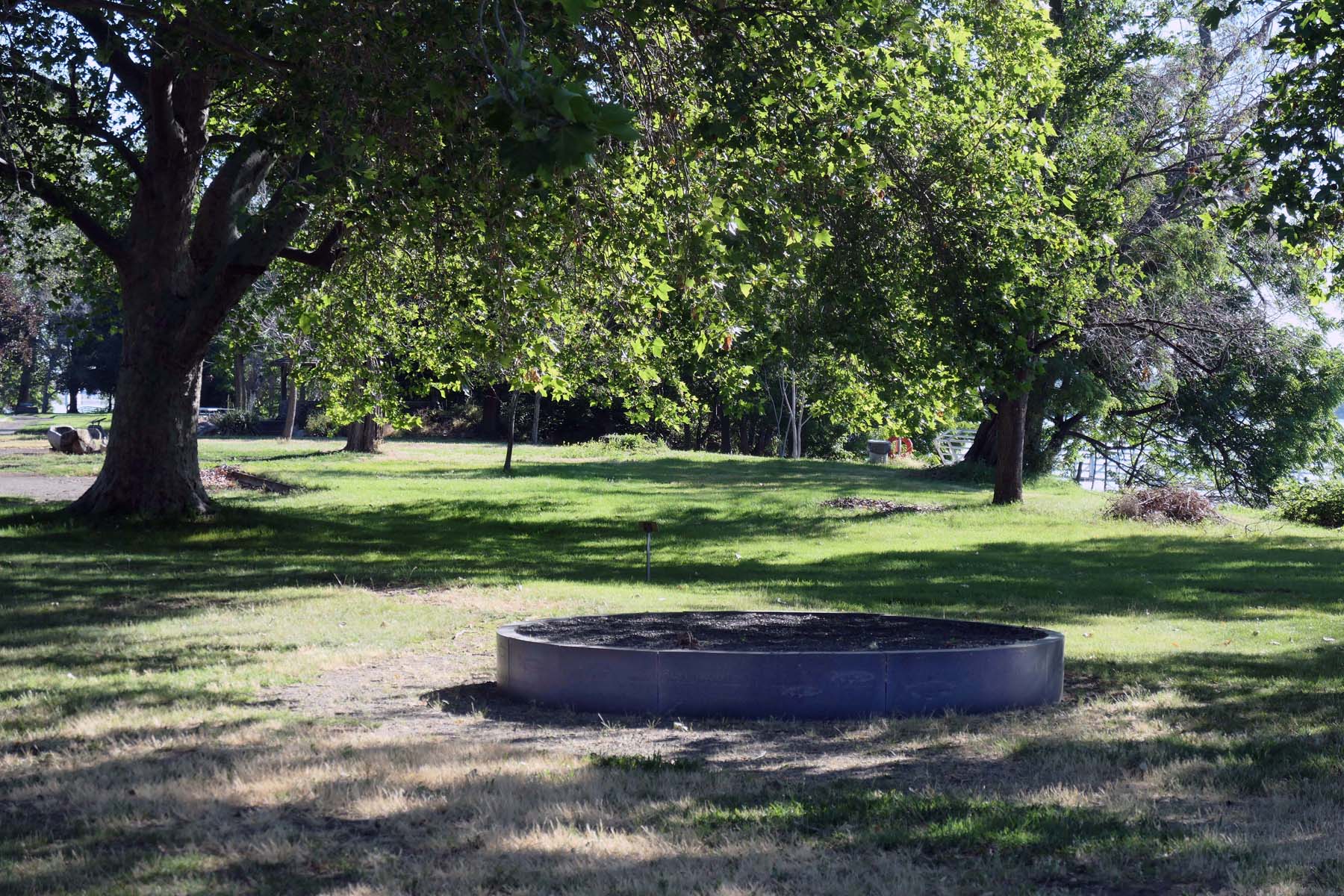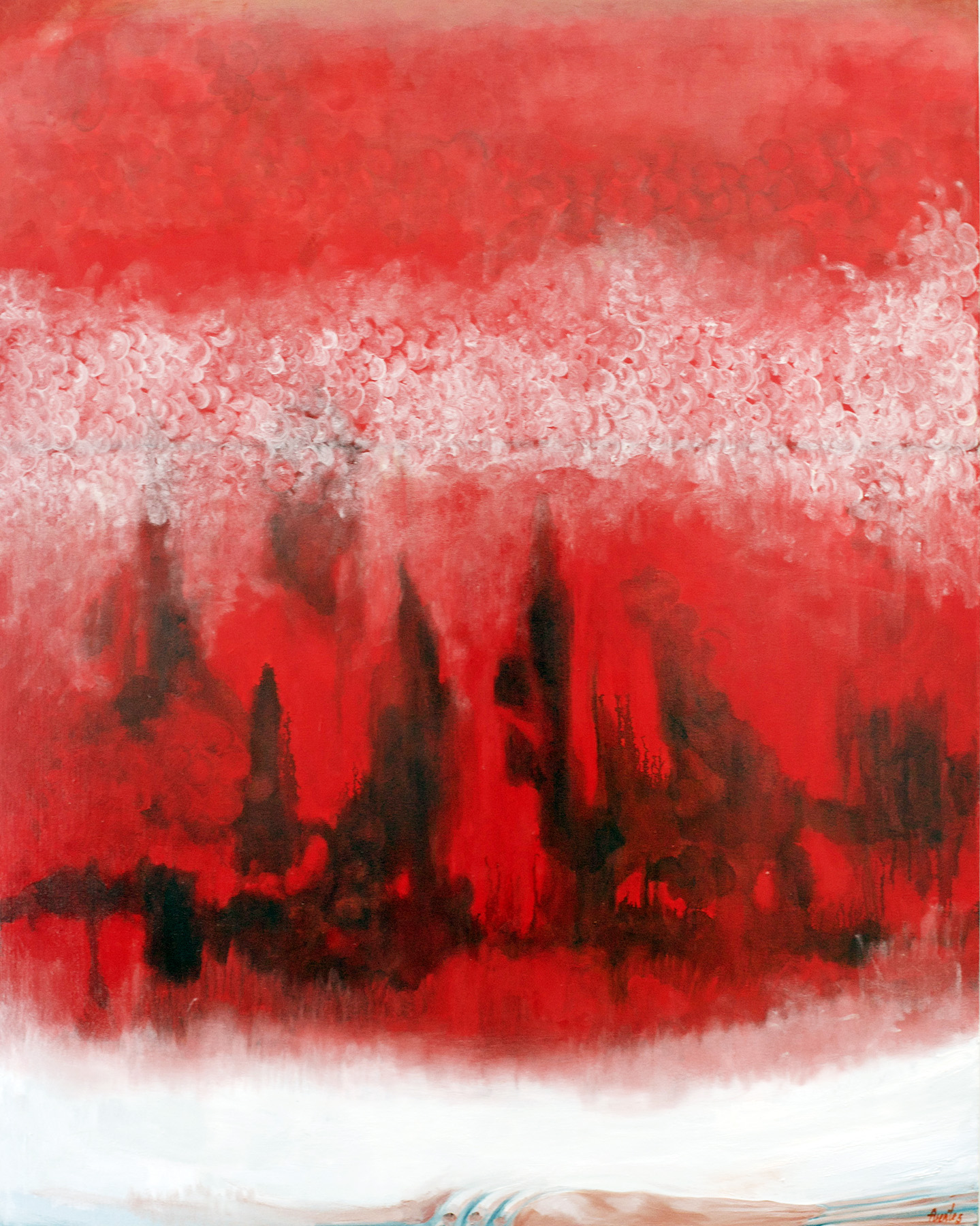It was early Saturday morning, heat already rising before 8 o’clock, when I drove through an eerily empty industrial landscape, filled with discarded machinery along railroad lines, dusty and bleak. Then came a long stretch of undeveloped acres of sage grass and sand, endless pylons stretching upwards into a pristine sky.



Eventually I arrived at the gate of the park that has been on my bucket list, yet another site of the Confluence Project’s art installations that, in their words, “connect people to the history, living cultures, and ecology of the Columbia River system through Indigenous voices.”


The gates of Sacajawea Historical State Park, a 267-acre day-use park at the confluence of the Snake and Columbia rivers near Pasco, WA, were still locked, but the sign informed me that you had to pay for access and warned of contact with birds, since avian flu has been making the rounds. A friendly caretaker let me into a green oasis of mature trees, surrounded by sparkling water, filled with bird song and not a soul in sight. I know, Saturday at 8 a.m. Probably a haven for picnics, family reunions and splashing kids come noon, for those who can afford the Discovery pass on land that was a traditional (free) gathering place for the Plateau tribes for 10 000 years. Until the Nez Perce War of 1877, that is, after which large gatherings at the confluence of the Snake River and Columbia River were no longer a possibility.

The site, a land spit reaching out into both rivers, is of historical note since Lewis & Clark and their Corps of Discovery camped there for 2 nights in 1805 amongst gathering tribes, led to the place by a young Lemhi-Shoshone woman, Sacagawea, who served as translator, guide and life saver to the expeditions because of her ability to secure plant food when hunting was scarce and her function as token to announce peaceful intentions – the presence of women was a sign that it was not a war party. (I am using the spelling that is now assumed to be the correct one, but left it as is in the name of the park. I am also hoping to write about how she and her role is perceived by Native Americans at a later point, having learned that it is complex.)


In any case, fast forward to 1927, when colonial settlers, the railroad and saw mill industries were firmly established in Pasco. The Daughters of the Pioneers of Washington, an organization with the purpose to “preserve the history and perpetuate the sentiment relating to pioneer days in the State of Washington, including historical sites, documents, records, and relics,” decided to celebrate the Corps of Discovery and Sacagawea’s contributions by placing a marker with granite slabs and river stones and build a park around it.


They planted trees, (with later WPA funded development adding over 200 shrubs and 500 trees, American and European sycamore, Norway and silver maple, sweet gum, American linden, black and honey locust, oak, black cottonwood, Lombardy poplar, Russian olive, blue spruce, and several species of pine among them.




Four years later, the group deeded the property to the State Parks Committee, and the transfer initiated more building and improvements. Central to the park named for her is the Sacajawea Interpretive Center, built in in Art Moderne style 1938/40. The museum features interactive exhibits on the Corps of Discovery, Sacagawea and the Sahaptian-speaking tribes of the region, and was still closed when I visited the park. Interpretative signs across the park as well as objects and structures outside inform about some of the history of the site.




I had come for something else, however: Maya Lin‘s seven Story Circles, which invite us to understand the site from a very different perspective, that of those driven from it.
I had just arrived in the U.S. in 1981 when the controversy around Maya Lin’s design for the Vietnam Memorial erupted. Opponents referred to the wall as an “open urinal,” suggested, for an inscription, the words “Designed by a gook,” and described Lin’s memorial as “a black gash of shame.” The National Review referred to Lin’s design as “Orwellian glop.” Tom Wolfe and Phyllis Schlafly called it “a monument to Jane Fonda.” Ross Perot said that it was “something for New York intellectuals.” (Ref.) Her design, sunken into the ground, consists of black granite slabs inscribed with the names of the dead and missing, but her critics managed to dilute the powerful work, with Veteran organizations, her supposed allies, caving: representational statues were added later, although at some distance. I was in awe how such a young woman could hold her own against powerful force; I was also taken by a design that made you not look up at a sculpture in admiration of particular persons or actions, as so much of the German memorial scene at the time consisted of.








Lin’s reaction and her path forward were captured some years back (2009) in a terrific essay based on interviews by Portland writer Camela Raymond in Portland Monthly. By the year 2000 Lin had turned to the Confluence Project, a series of six outdoor installations at points of historic interest along 300 miles of the Columbia and Snake Rivers in the State of Washington. A collaboration with other artists, architects, landscape designers and the native tribes of the Pacific Northwest, it served her interest in what she calls “memory work,” aimed, in her words, at inspiring reflection of the past, rather than simply mourning what’s lost. In some ways it is a project concerned with restoration instead. Finished projects include, at this date, Cape Disappointment State Park, the Vancouver Land Bridge, the bird blind at Sandy River Delta, Chief Timothy Park, and the Story Circles that I was now seeing for the first time.
“Seven cut basalt circles are laid out in the park and etched with texts taken from tribal stories, Lewis and Clark’s journals, and Yakama elders that explore the native cultures, language, flora, fauna, geology, and natural history of the site. Each of the circles graphically describes a different aspect of this place: the types of fish, native plants gathered, traded goods, the geology of the place, the mythic creation story of the place and at the southern-most tip, a listing of all the tribes who came through the area placed within the only form, not of a circle but of the imprint of a traditional long house that was the architectural form used for their lodge-style meetinghouses.”

What is most striking is how little these structures command attention and how much they have you focus on the environment as a whole. Whether sunk or elevated, they are “down to earth,” blending with the land, reminding us of peoples for whom the connection to land is central to their beliefs and culture and for whom the forced removal from their land is a central trauma across generations.






They allow room to be exposed to other factors shaping the environment as well, the industries and man-made structures that surround what was once a site for tribal gathering, exchanges, trade and celebrations. They make you move around, from one circle to the next and around them, to read the inscriptions (in language that did not rely traditionally on the written word,) with each move opening up different vistas. You will see pelicans, fishermen, the local bridges and, lucky me, wild turkeys in “let’s impress” mode.









It is a hallmark of all of the sites I have seen so far that they combine the beauty of an idea or a work or art with some functionality, always educating about what was encountered at the time of the Corp’s arrival, from the perspective of those displaced. The fish-cleaning table at Cape disappointment is a central concept to all the Salmon people, but it can – and is! – also be used for the actual gutting. The bird-blind at 1000 acres has the names of the bird-, fish and animal species encountered by Lewis & Clark at the time engraved on its walls; these walls consist of open slats, though, that allow the environment, the river, the woods, the sounds of the birds to be present for your senses, speaking to continuity.

The erasure of memory that is often concomitant to the forced dissemination of a people is given a counter weight in this land art. The Confluence Project goes beyond that link to the past, however. They have an incredible education library that connects to detailed information for each site. For Sacajawea State Park, for example, you can learn about the history and the environmental concerns from multiple compilations. Besides sections for History and Ecology there is much material on Living Culture, informing about indigenous life ways, sovereignty, tribes today and offering an interview collection.





You can also learn about the consequences of the structural hierarchies that resulted from settler colonialism extending into the present. Here is just one example, from a Confluence podcast featuring three Indigenous scholars and activists, Bobby Conner, Emily Washines and Deana Dartt, discussing the memorializing of history. I learned that the scientific assessment of acceptable toxicity levels of the water in the Snake and Columbia river (both polluted by run-off from the nearby Hanford nuclear reactors and threatened by an underground plume of radioactivity,) is based on the amount of salmon consumed by non-Native Americans. That amount is a minute fraction of what tribal members consume whose diet and culture centers around fish. Toxicity rises to levels that induce cancer and other health problems for this previously healthy population whose dietary customs, driven by economic necessity as well, were not factored into the equations.


It is not all about the past. It is about the long shadows reaching into a present which has not been freed from structural and systemic factors that affect the very existence of the tribes of the Plateau. A shift from White to non-White perspective incorporated in the way that the Confluence Project and Lin’s art tell stories alerts us to the connections across time. We have to show up, though, and listen. If necessary, on a Saturday, early in the morning, spared all distractions.
I was driving back home along Highway 14, parallel to the river, renewable energy sources in sight, but also the dams that so dramatically altered the landscape and the life of its inhabitants. It is a blessed landscape, with all its harshness, in need to be, at least, protected, at best restored in ways that make living here long-term sustainable. For all.













































